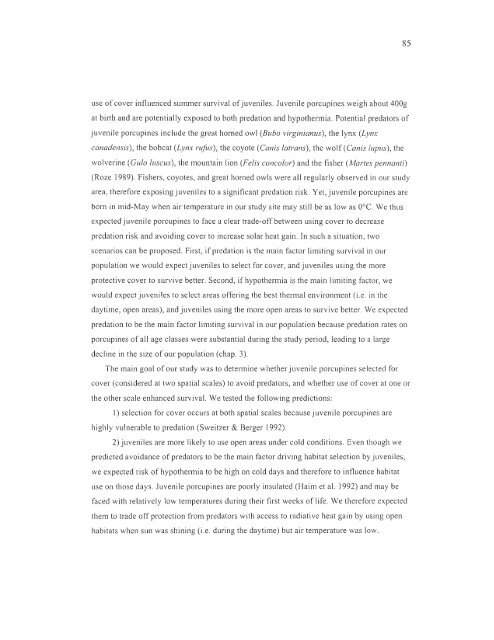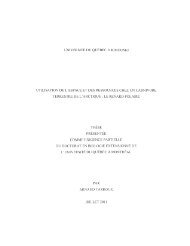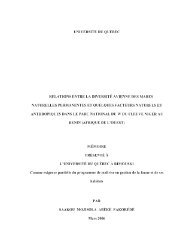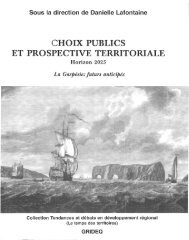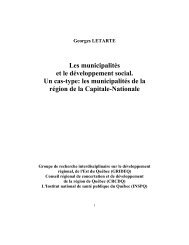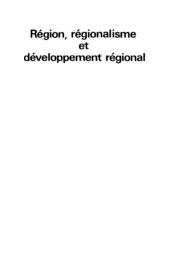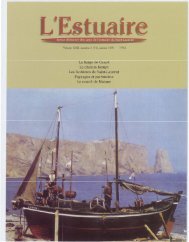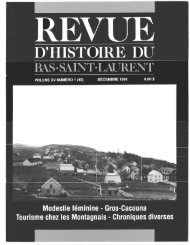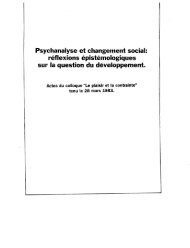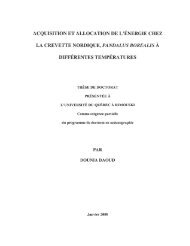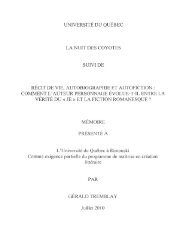influence du climat et de la prédation sur l'utilisation de l'habitat et la ...
influence du climat et de la prédation sur l'utilisation de l'habitat et la ...
influence du climat et de la prédation sur l'utilisation de l'habitat et la ...
Create successful ePaper yourself
Turn your PDF publications into a flip-book with our unique Google optimized e-Paper software.
85<br />
use of coyer <strong>influence</strong>d summer <strong>sur</strong>vival of juveniles. Juvenile porcupines weigh about 400g<br />
at bilth and are potentially exposed to both predation and hypothermia. Potential predators of<br />
juvenile porcupines inc\u<strong>de</strong> the great horned owl (Bubo virginianus), the lynx (Lynx<br />
cana<strong>de</strong>nsis), the bobcat (Lynx rufils), the coyote (Canis <strong>la</strong>trans), the wolf (Canis lupus), the<br />
wolverine (Gulo luscus), the mountain lion (Fe lis concolor) and the fisher (Martes pennanti)<br />
(Roze 1989). Fishers, coyotes, and great horned owls were ail regu<strong>la</strong>rly observed in our study<br />
area, therefore exposing juveniles to a significant predation risk. Y<strong>et</strong>, juvenile porcupines are<br />
born in mid-May when air tempe rature in our study site may still be as low as O°e. We thus<br />
expected juvenile porcupines to face a clear tra<strong>de</strong>-off b<strong>et</strong>ween using coyer to <strong>de</strong>crease<br />
predation risk and avoiding co ver to increase so<strong>la</strong>r heat gain. ln such a situation, two<br />
scenarios can be proposed. First, if predation is the main factor limiting <strong>sur</strong>vival in our<br />
popu<strong>la</strong>tion we would expect juveniles to select for coyer, and juveniles using the more<br />
protective coyer to <strong>sur</strong>vive b<strong>et</strong>ter. Second, if hypothermia is the main limiting factor, we<br />
would expect juveniles to select areas offering the best thennal environment (i .e. in the<br />
daytime, open areas), and juveniles using the more open areas to <strong>sur</strong>vive b<strong>et</strong>ter. We expected<br />
predation to be the main factor limiting <strong>sur</strong>vival in our popu<strong>la</strong>tion because predation rates on<br />
porcupines of ail age c<strong>la</strong>sses were substantial <strong>du</strong>ring the study period, leading to a <strong>la</strong>rge<br />
<strong>de</strong>cline in the size of our popu<strong>la</strong>tion (chap. 3).<br />
The main goal of our study was to d<strong>et</strong>ermine wh<strong>et</strong>her juvenile porcupines selected for<br />
coyer (consi<strong>de</strong>red at two spatial scales) to avoid predators, and wh<strong>et</strong>her use of cover at one or<br />
the other scale enhanced <strong>sur</strong>vival. We tested the following predictions:<br />
1) selection for cover occurs at both spatial scales because juvenile porcupines are<br />
highly vulnerable to predation (Sweitzer & Berger 1992).<br />
2) juveniles are more likely to use open areas un<strong>de</strong>r cold conditions. Even though we<br />
predicted avoidance of predators to be the main factor driving habitat selection by juveniles,<br />
we expected risk of hypothermia to be high on cold days and therefore to <strong>influence</strong> habitat<br />
use on those days. Juvenile porcupines are poorly insu<strong>la</strong>ted (Haim <strong>et</strong> al. 1992) and may be<br />
faced with re<strong>la</strong>tively low tempe ratures <strong>du</strong>ring their first weeks of life. We therefore expected<br />
them to tra<strong>de</strong> off protection from predators with access to radiative heat gain by using open<br />
habitats wh en sun was shining (i.e. <strong>du</strong>ring the daytime) but air temperature was low.


